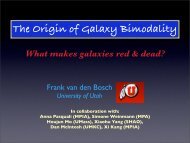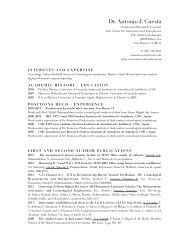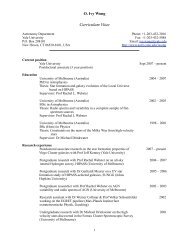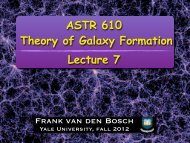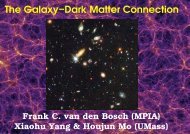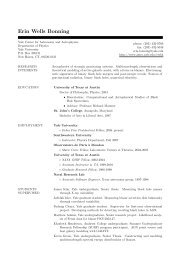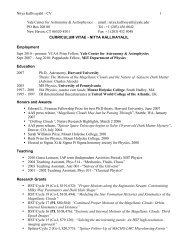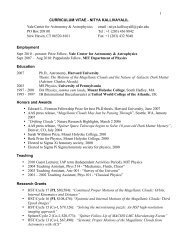ASTR 610 Theory of Galaxy Formation Lecture 16
ASTR 610 Theory of Galaxy Formation Lecture 16
ASTR 610 Theory of Galaxy Formation Lecture 16
Create successful ePaper yourself
Turn your PDF publications into a flip-book with our unique Google optimized e-Paper software.
Angular Momentum Transport<br />
J<br />
For a given angular momentum, , the state <strong>of</strong> lowest energy, and hence the state<br />
preferred by nature, is the one in which all mass except an infinitesimal fraction<br />
collapses into a black hole, while is on a Keplerian orbit with radius given by<br />
δM<br />
J = δM (GMR) 1/2<br />
R<br />
δM<br />
where<br />
M<br />
is the mass <strong>of</strong> the black hole.<br />
Clearly, this is very different from a realistic disk galaxy, whose mass distribution is<br />
close to exponential.....<br />
Reason for this paradox is that although lowest energy state is preferred, its<br />
realization requires very efficient transport <strong>of</strong> angular momentum from inside out.<br />
There are several mechanisms that can cause such angular momentum transport:<br />
secular<br />
evolution<br />
viscosity (gas only)<br />
resonant scattering (stars & gas)<br />
(Lin & Pringle 1987)<br />
(Sellwood & Binney 2002)<br />
hierarchical<br />
formation<br />
dynamical friction & ram pressure acting on gas clouds<br />
“angular momentum catastrophe”<br />
<strong>ASTR</strong> <strong>610</strong>: <strong>Theory</strong> <strong>of</strong> <strong>Galaxy</strong> <strong>Formation</strong> © Frank van den Bosch: Yale 2012



